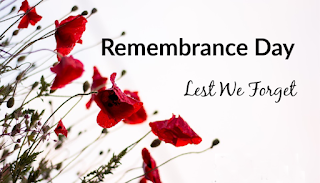
Every year on November 11th, Remembrance Day commemorates those who have served in the military and those who have died in battle. It is observed on November 11th, at 11:00 a.m., which is the 11th month, 11th day, and 11th hour – the time and date in 1918 when the guns fell silent, effectively ending hostilities. The British Commonwealth first observed Remembrance Day in 1919, though it was known as Armistice Day at the time. Until 1930, Remembrance Day was known as Armistice Day, and it was observed on the Monday following the 11th of November. The name was changed to Remembrance Day in 1931, and the date was set for November 11th.
Interesting facts about Remembrance Day:
The poppy is used as a symbol of the blood shed during the war on Remembrance Day.
Following the famous poem In Flanders Fields, written by John McCrae during the First World War, poppies became a symbol for Remembrance Day. During World War I, poppies grew on the graves of soldiers in Flanders.
After reading John McCrae’s poem In Flanders Fields, an American humanitarian named Moina Michael began wearing and giving poppies to people to wear in November 1918 to honor fallen soldiers.
In 1920, the American Legion officially adopted the poppy.
In 1921, the Royal British Legion adopted the poppy as a Remembrance Day symbol.
The money raised by legions around the world asking for donations for poppies is used to help injured and retired soldiers.
The Royal Canadian Legion recommends wearing the poppy on the left side, close to the heart. It should be worn from the last day of October until 11:00 a.m. on November 11th. The Legion suggests that it be placed at a cenotaph rather than thrown away.
For many years, poppies had a black center. They were changed to green in 1980, and they were changed back to black in 2002.
In some countries, Remembrance Day is known as Veteran’s Day, Armistice Day, or Poppy Day. Most British Commonwealth countries, as well as Canada, observe Remembrance Day.
On November 11th, a moment of silence is traditionally observed at 11:00 a.m.
The Armistice was signed at 5:00 a.m. on November 11th, 1918, but peace was not to be achieved until 11:00 a.m. that day, according to the terms.
Remembrance Day is observed on the second Sunday of November in the United Kingdom.
The United States renamed Armistice Day (November 11th) Veterans Day in 1954.
The bugle is frequently played at military funerals and on Remembrance Day to represent the fact that soldiers can rest in peace. During the war, the bugle signaled to soldiers that it was time to return to their barracks and sleep.
Gun salutes are used in some Remembrance Day ceremonies around the world, including Canada.
Remembrance Day is observed as a national holiday, a public holiday, or a day of observation in different countries.









